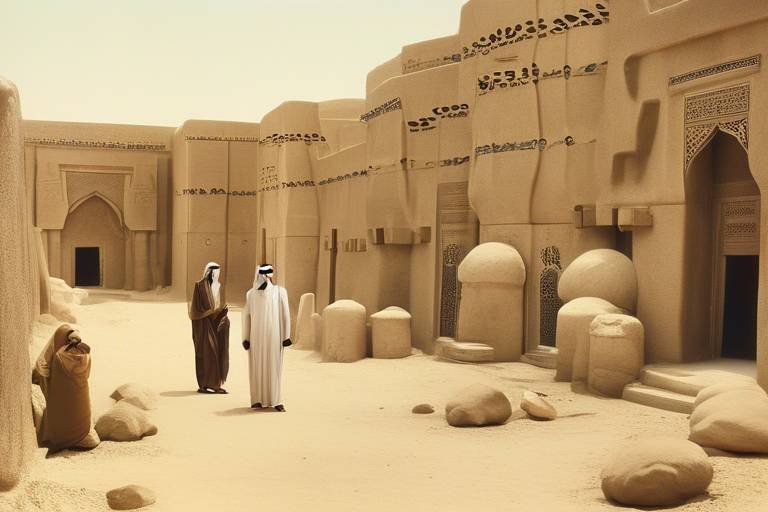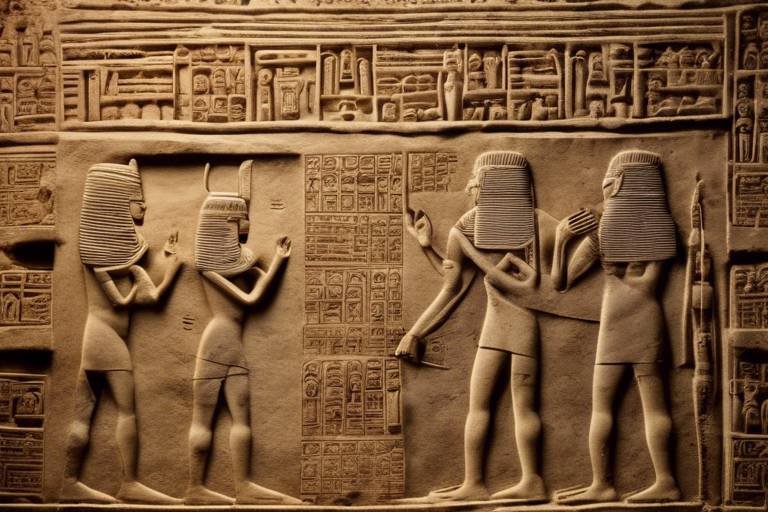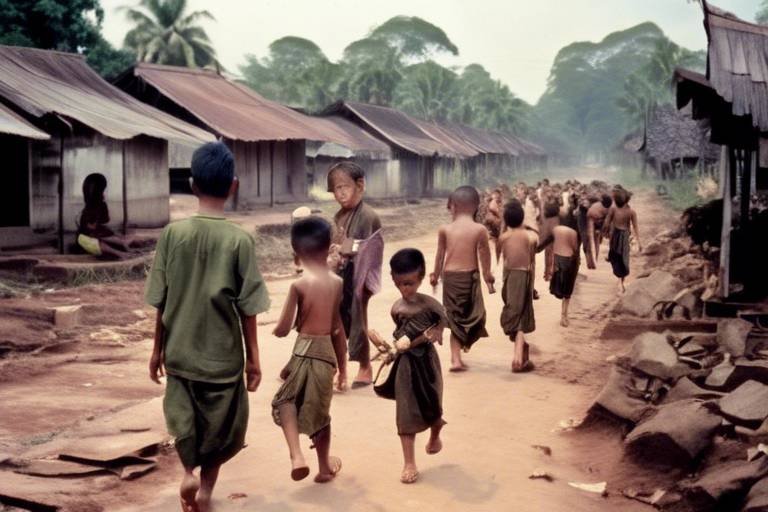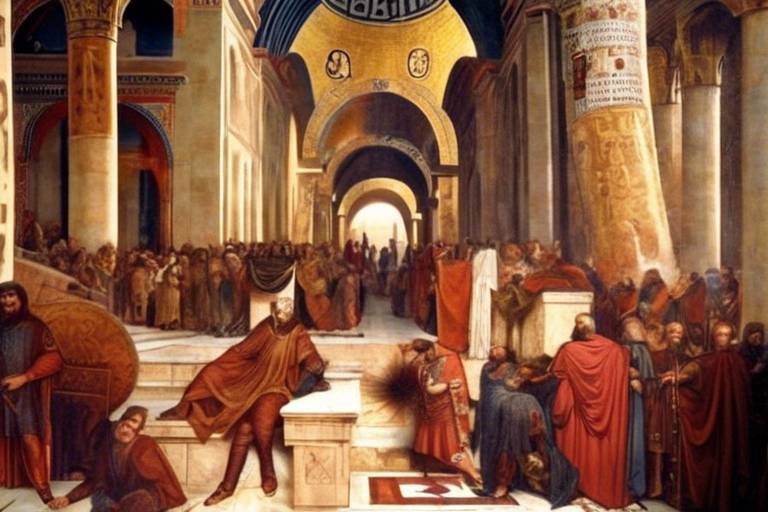The Legacy of the Ancient Khmer Civilization
The ancient Khmer civilization, nestled in the heart of Southeast Asia, stands as a testament to the ingenuity and cultural richness of a bygone era. Flourishing primarily in present-day Cambodia, the Khmer civilization left an indelible mark on history, with its architectural marvels and enduring traditions captivating the imagination of modern-day explorers and scholars alike.
At the forefront of Khmer architectural prowess lies the magnificent Angkor Wat, a jewel in the crown of Khmer civilization. This sprawling complex, the largest religious monument globally, is a masterpiece of design and spirituality. Its intricate carvings and symbolic significance continue to awe visitors, offering a glimpse into the spiritual beliefs and artistic achievements of the Khmer people.
The rise and fall of the Khmer Empire paint a vivid picture of a once-mighty civilization that reached its zenith under illustrious rulers like Jayavarman II and Suryavarman II. However, internal strife, external pressures, and environmental challenges eventually led to the empire's decline, underscoring the fragile nature of power and influence.
Art and sculpture were integral components of Khmer cultural expression, with exquisite sculptures, reliefs, and artifacts portraying Hindu and Buddhist deities, mythological tales, and scenes from daily life. These artistic creations not only adorned temples and palaces but also served as a visual narrative of the Khmer worldview and religious beliefs.
The unique Khmer language and script played a pivotal role in shaping Cambodian culture and literature, with inscriptions serving as vital historical records. The intricate script, with its graceful curves and loops, continues to intrigue linguists and historians, offering insights into the linguistic heritage of the Khmer people.
Delving into the rich tapestry of Khmer ceremonies and festivals unveils a vibrant world of traditions and rituals that reflect the spiritual beliefs and cultural practices of the Khmer people. Celebrations like Khmer New Year and Pchum Ben provide a window into the soul of a civilization steeped in reverence for its ancestors and deities.
Embarking on a culinary journey through Khmer cuisine reveals a fusion of flavors and aromas, characterized by aromatic herbs, pungent spices, and tropical ingredients. The culinary heritage of the Khmer people, passed down through generations, offers a tantalizing glimpse into the gastronomic delights of the past.
The graceful movements of Khmer classical dance and the melodious strains of traditional Khmer music resonate with the echoes of ancient stories and cultural expressions. These art forms, steeped in tradition and symbolism, serve as a living testament to the creativity and artistic finesse of the Khmer civilization.
Efforts to preserve the legacy of the ancient Khmer civilization, epitomized by UNESCO World Heritage sites like the Angkor Archaeological Park, underscore the importance of safeguarding cultural heritage for future generations. These initiatives aim to ensure that the splendor and significance of the Khmer civilization endure the test of time, serving as a beacon of inspiration for all who seek to delve into the past.

Angkor Wat: Jewel of Khmer Architecture
When it comes to architectural marvels, Angkor Wat stands out as the crown jewel of the ancient Khmer civilization. This magnificent temple complex, located in Cambodia, is not just a structure but a symbol of spiritual devotion and artistic excellence. Built in the 12th century by King Suryavarman II, Angkor Wat is a testament to the ingenuity and craftsmanship of the Khmer people.
The grandeur of Angkor Wat is evident in its sheer size and intricate design. From the towering central spire to the elaborate bas-reliefs that adorn its walls, every detail of the temple exudes a sense of awe and reverence. The architectural layout of Angkor Wat reflects the cosmological beliefs of the Khmer Empire, with its five towers representing the peaks of Mount Meru, the mythical abode of Hindu gods.
One of the most striking features of Angkor Wat is its extensive bas-reliefs, which depict scenes from Hindu mythology and historical events. These intricate carvings not only showcase the artistic skills of the Khmer artisans but also serve as a visual narrative of the culture and beliefs of the time. Walking through the galleries of Angkor Wat is like stepping back in time and witnessing the glory of a bygone era.
Moreover, the spiritual significance of Angkor Wat cannot be overstated. As a place of worship dedicated to the Hindu god Vishnu, the temple complex embodies the Khmer people's deep-rooted religious faith and devotion. The serene atmosphere within the temple walls, coupled with the sound of chanting and the scent of incense, creates a sense of tranquility and reverence that is truly captivating.
Today, Angkor Wat continues to inspire awe and admiration from visitors around the world. Its timeless beauty and cultural significance make it not just a historical monument but a living testament to the enduring legacy of the ancient Khmer civilization. Exploring Angkor Wat is like unraveling a mystery, where every stone has a story to tell and every carving holds a secret waiting to be discovered.

Khmer Empire: Rise and Fall
Exploring the rich history and lasting impact of the ancient Khmer civilization that thrived in Southeast Asia, particularly in present-day Cambodia, and left behind remarkable architectural wonders and cultural traditions.
Discovering the grandeur and symbolism of Angkor Wat, the largest religious monument in the world and a masterpiece of Khmer architecture, showcasing intricate carvings and spiritual significance.
Tracing the rise of the Khmer Empire to its peak under rulers like Jayavarman II and Suryavarman II, and examining the factors that led to its eventual decline and fall.
The Khmer Empire, once a powerful and influential civilization in Southeast Asia, reached its zenith during the reign of rulers such as Jayavarman II and Suryavarman II. These visionary leaders expanded the empire's territories, constructed grand temples and monuments, and established a sophisticated administrative system that enabled the empire to flourish. However, internal strife, external invasions, and environmental factors eventually contributed to the decline of the Khmer Empire.
Internal conflicts among the ruling elite, competition for succession, and challenges in maintaining control over vast territories weakened the empire from within. Additionally, external threats from neighboring kingdoms and empires posed significant challenges to the Khmer Empire's stability and security. The empire's reliance on hydraulic infrastructure for agriculture, such as the intricate network of reservoirs and canals, made it vulnerable to environmental changes and natural disasters, further hastening its decline.
Despite its eventual fall, the legacy of the Khmer Empire continues to endure through its architectural marvels, artistic achievements, and cultural heritage. The empire's contributions to art, architecture, language, and religion have left an indelible mark on the region and continue to fascinate scholars and visitors alike.
Exploring the artistic expressions of the Khmer civilization through sculptures, reliefs, and artifacts that depict Hindu and Buddhist deities, mythological scenes, and everyday life.
Understanding the unique Khmer language and its ancient script, which have influenced modern Cambodian culture and literature, and exploring the role of inscriptions in recording history.
Delving into the traditional ceremonies, rituals, and festivals of the Khmer people, such as Khmer New Year and Pchum Ben, which reflect their religious beliefs and cultural practices.
Savoring the flavors of Khmer cuisine, characterized by aromatic herbs, spices, and tropical ingredients, and exploring the culinary heritage passed down through generations.
Appreciating the graceful movements of Khmer classical dance and the melodious tunes of traditional Khmer music, which have preserved ancient stories and cultural expressions.
Examining efforts to preserve and protect the legacy of the ancient Khmer civilization, including UNESCO World Heritage sites like Angkor Archaeological Park, for future generations to appreciate.

Khmer Art and Sculpture
Khmer art and sculpture are integral components of the rich cultural tapestry woven by the ancient Khmer civilization. Through intricate carvings, majestic sculptures, and elaborate reliefs, the Khmer people expressed their devotion to Hindu and Buddhist deities, captured mythological tales, and depicted scenes from everyday life with remarkable detail and symbolism.
The art of the Khmer civilization is characterized by its grandeur and spiritual essence, evident in monumental structures like Angkor Wat and Bayon Temple. These architectural marvels not only served as religious sanctuaries but also as artistic masterpieces, showcasing the craftsmanship and creativity of Khmer artisans.
One of the most iconic examples of Khmer artistry is the image of the Apsara, celestial nymphs known for their graceful movements and ethereal beauty. These divine dancers are often depicted in intricate stone carvings adorning temple walls, embodying the elegance and mystique of Khmer culture.
Khmer sculpture also encompasses a wide range of subjects, from towering stone guardians known as Dvarapalas to serene Buddha statues exuding tranquility and wisdom. Each sculpture tells a story, whether it be a heroic legend, a religious allegory, or a portrayal of daily life in ancient Khmer society.
The art and sculpture of the Khmer civilization not only served as a form of artistic expression but also as a means of preserving history and cultural heritage. Through these visual representations, the Khmer people immortalized their beliefs, traditions, and values, leaving behind a legacy that continues to inspire awe and admiration to this day.

Khmer Language and Script
The Khmer language, spoken by the Khmer people of Cambodia, is a crucial part of the country's cultural identity. With its roots deeply intertwined with the ancient Khmer civilization, the language has evolved over centuries, incorporating influences from Sanskrit and Pali. Khmer script, known as "Aksar Khmer," is a unique writing system with its own set of characters that beautifully represent the sounds of the language.
One of the distinctive features of the Khmer script is its elegance and symmetry, making it visually captivating. Each character is a work of art in itself, reflecting the artistic sensibilities of the Khmer people. The script has played a vital role in preserving the rich literary heritage of Cambodia, with ancient inscriptions providing valuable insights into the history and culture of the Khmer civilization.
The Khmer language and script have been instrumental in shaping Cambodian literature, poetry, and religious texts. They have served as a medium for expressing profound philosophical ideas, epic narratives, and spiritual beliefs. The intricate calligraphy of Khmer manuscripts is a testament to the skill and dedication of scribes who meticulously transcribed ancient texts.
Despite the challenges posed by modernization and globalization, efforts are being made to promote and preserve the Khmer language and script. Schools in Cambodia teach Khmer as a primary language, ensuring that future generations continue to embrace their linguistic heritage. Organizations dedicated to cultural preservation work tirelessly to safeguard the script and promote its usage in various forms of media.

Khmer Ceremonies and Festivals
Khmer Ceremonies and Festivals hold a special place in the vibrant tapestry of Khmer culture, providing a glimpse into the spiritual beliefs and traditional practices of the Khmer people. These ceremonies and festivals are deeply rooted in the rich history of the ancient Khmer civilization, reflecting a harmonious blend of Hindu and Buddhist influences.
One of the most significant celebrations in the Khmer calendar is the Khmer New Year, known as "Chaul Chnam Thmey." This three-day festival marks the end of the harvest season and the beginning of a new year, filled with joyous gatherings, colorful processions, and traditional rituals. It symbolizes renewal and rebirth, with communities coming together to pay homage to their ancestors and seek blessings for the year ahead.
Another important event is Pchum Ben, or the Ancestors' Day festival, which honors deceased relatives and ancestors. During this solemn period, families visit pagodas to offer food and prayers to the spirits of their loved ones, seeking to bring peace and merit to the departed souls. The festival underscores the Khmer belief in the interconnectedness of past, present, and future generations.
Throughout the year, various ceremonies are held to commemorate religious occasions, such as Vesak, the celebration of Buddha's birth, enlightenment, and death. Devotees gather at temples to participate in rituals, listen to sermons, and make offerings, fostering a sense of community and spiritual devotion.
Moreover, traditional weddings in Cambodia are elaborate affairs steeped in age-old customs and rituals. From the intricate rituals of the engagement ceremony to the colorful processions of the wedding day, Khmer weddings exemplify the cultural values of love, respect, and unity, symbolizing the union of two families and the continuation of traditions.
As the sun sets over the temples of Angkor, the echoes of traditional music and dance fill the air during festivals like the Water Festival, or "Bon Om Touk." This annual event celebrates the reversal of the Tonle Sap River's flow, attracting crowds with boat races, fireworks, and lively performances that showcase the beauty and grace of Khmer arts.
Overall, Khmer Ceremonies and Festivals serve as a testament to the enduring legacy of the ancient Khmer civilization, preserving age-old traditions and cultural practices for future generations to cherish and uphold.

Khmer Cuisine: Flavors of the Past
When it comes to Khmer cuisine, one is immediately transported to a world of rich flavors and aromatic spices that have stood the test of time. The culinary heritage of the Khmer people is a reflection of their history, culture, and geographical abundance, creating a unique tapestry of tastes that tantalize the senses.
At the heart of Khmer cuisine are the vibrant flavors of aromatic herbs and spices that infuse every dish with a burst of taste. Lemongrass, galangal, turmeric, and kaffir lime leaves are just a few of the key ingredients that lend a distinctive aroma and depth of flavor to traditional Khmer dishes.
One cannot talk about Khmer cuisine without mentioning the use of tropical ingredients that are abundant in the region. Fresh seafood, coconut milk, mangoes, and bananas are staples in Khmer cooking, adding a touch of sweetness and freshness to the savory dishes.
From the famous Fish Amok, a delicate fish curry steamed in banana leaves, to the refreshing Green Mango Salad with a zesty dressing, Khmer cuisine offers a diverse range of flavors that cater to every palate. Each dish tells a story of the past, preserving ancient culinary traditions that have been passed down through generations.
Moreover, the art of food presentation is highly valued in Khmer culture, with dishes often served in intricate arrangements that resemble works of art. The visual appeal of Khmer cuisine adds another dimension to the dining experience, making it a feast for both the eyes and the taste buds.

Khmer Dance and Music
Khmer Dance and Music hold a significant place in the cultural heritage of the ancient Khmer civilization, serving as a vibrant expression of storytelling and artistic tradition. The graceful movements of Khmer classical dance, characterized by intricate hand gestures and elaborate costumes, narrate ancient tales of love, mythology, and spirituality. This traditional dance form not only entertains but also preserves the rich history and cultural values of the Khmer people.
Accompanying the mesmerizing dance performances is the melodious tunes of traditional Khmer music, which feature a blend of traditional instruments like the roneat (bamboo xylophone), tro (fiddle), and skor thom (drum). The rhythmic beats and enchanting melodies of Khmer music evoke a sense of nostalgia and pride, resonating with the soulful essence of Cambodian culture.
The symbiotic relationship between Khmer dance and music is akin to a harmonious duet, where each element complements the other to create a captivating sensory experience. Through intricate choreography and soul-stirring melodies, Khmer performers transport audiences to a realm where history, art, and emotion converge in a mesmerizing display of cultural richness.

Khmer Heritage Preservation
Preserving the rich heritage of the ancient Khmer civilization is a vital endeavor that ensures the legacy of this remarkable culture endures for generations to come. Efforts to safeguard the cultural and historical significance of Khmer heritage include the conservation of architectural marvels like the awe-inspiring Angkor Wat, a symbol of Khmer ingenuity and spiritual devotion. Through meticulous restoration and maintenance, these ancient structures stand as testaments to the Khmer people's artistic and architectural prowess.
Moreover, the inscription of sites such as the Angkor Archaeological Park on the UNESCO World Heritage list serves as a global recognition of the importance of protecting Khmer heritage. This designation not only raises awareness about the significance of these sites but also mobilizes resources and expertise to ensure their preservation. By safeguarding these cultural treasures, we can learn from the past and appreciate the ingenuity and creativity of the Khmer civilization.
Collaborative efforts between local communities, governmental authorities, and international organizations play a crucial role in the conservation and promotion of Khmer heritage. Education programs, museum exhibits, and cultural events further contribute to raising awareness about the value of Khmer heritage and the need for its protection. By engaging the public in the preservation process, a sense of ownership and pride in Khmer cultural heritage is fostered, ensuring its continued relevance and appreciation in the modern world.
Frequently Asked Questions
- What is the significance of Angkor Wat?
Angkor Wat is considered the jewel of Khmer architecture due to its grandeur, intricate carvings, and spiritual importance as the largest religious monument in the world.
- Who were the notable rulers of the Khmer Empire?
Rulers like Jayavarman II and Suryavarman II led the Khmer Empire to its peak, leaving a lasting legacy in the form of remarkable architectural wonders and cultural traditions.
- What themes are depicted in Khmer art and sculpture?
Khmer art and sculpture often portray Hindu and Buddhist deities, mythological scenes, and aspects of everyday life, showcasing the rich cultural heritage of the civilization.
- How has the Khmer language influenced modern Cambodian culture?
The unique Khmer language and ancient script have played a significant role in shaping modern Cambodian culture, particularly in literature and historical inscriptions.
- What are some traditional Khmer ceremonies and festivals?
Khmer people celebrate traditional ceremonies and festivals like Khmer New Year and Pchum Ben, reflecting their religious beliefs and cultural practices.
- What defines the flavors of Khmer cuisine?
Khmer cuisine is known for its aromatic herbs, spices, and tropical ingredients, showcasing a culinary heritage passed down through generations.
- How do Khmer dance and music preserve cultural expressions?
Khmer classical dance and traditional music convey ancient stories and cultural expressions through graceful movements and melodious tunes.
- What efforts are being made to preserve Khmer heritage?
Efforts to preserve the legacy of the ancient Khmer civilization include initiatives to protect UNESCO World Heritage sites like Angkor Archaeological Park for future generations.



















